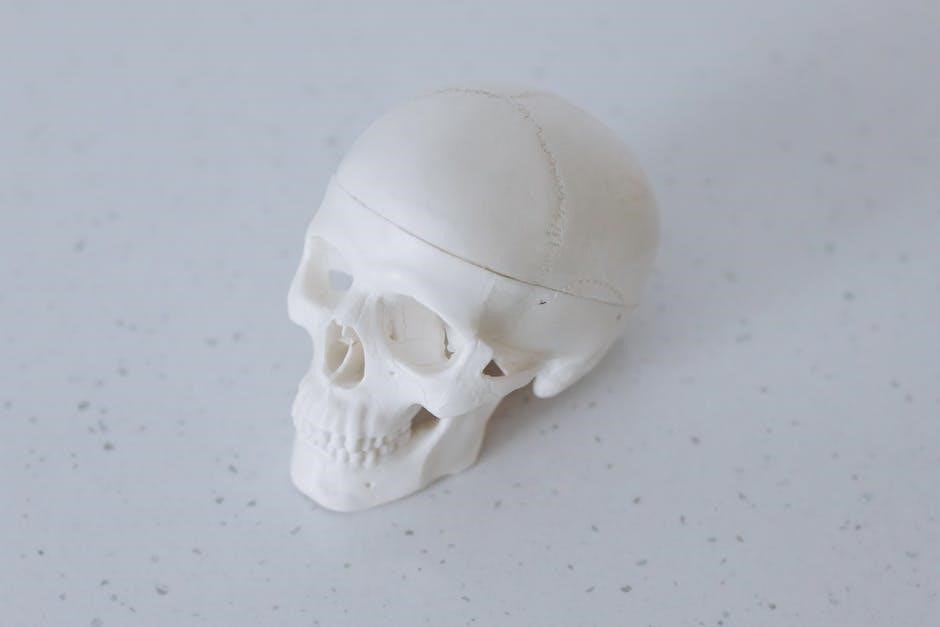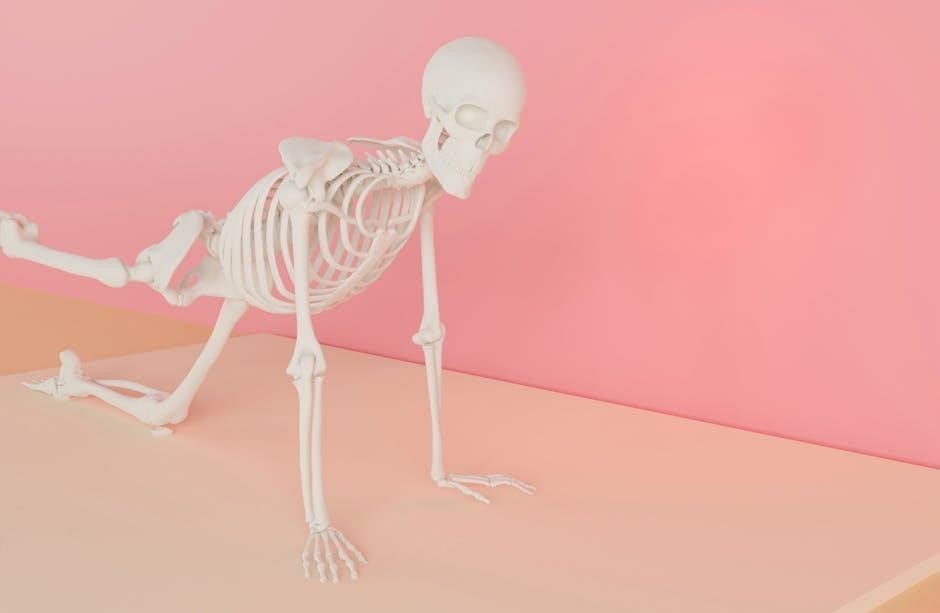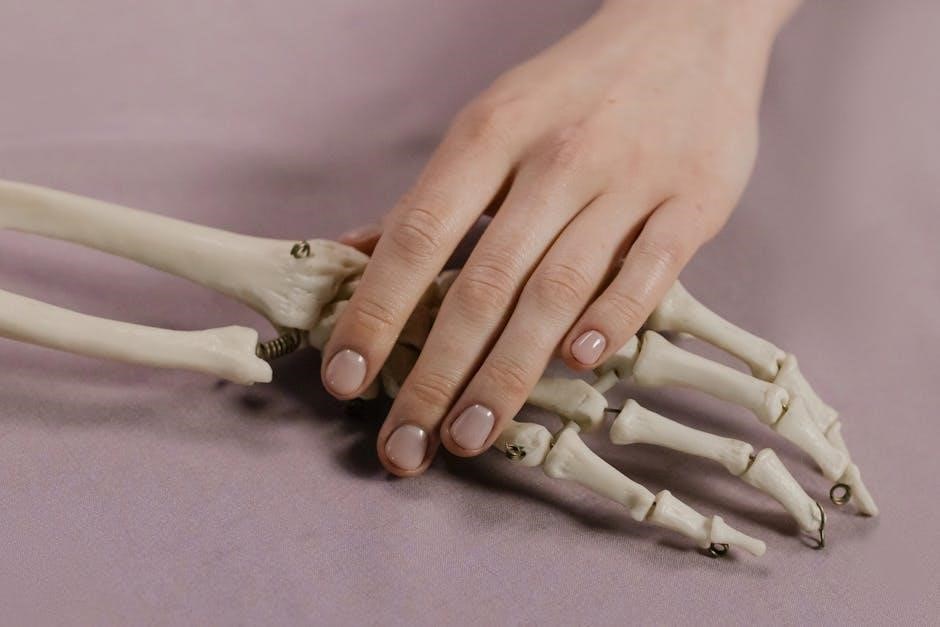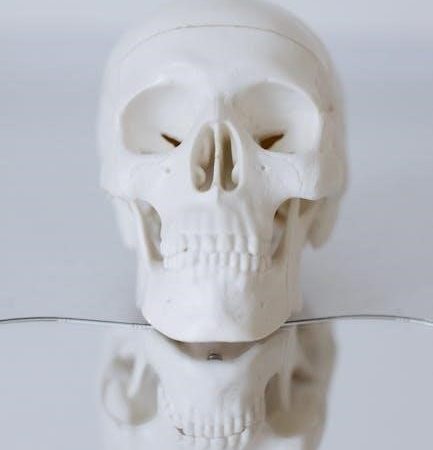Human anatomy and physiology is the scientific study of the structure and function of the human body. It provides a comprehensive understanding of how organs, systems, and cells work together to maintain life. This field combines biology, chemistry, and medicine, offering insights into the body’s mechanisms and processes. Through detailed textbooks, PDF guides, and online resources, students can explore topics like anatomical terminology, body systems, and physiological processes. Effective study tools, such as practice questions and visual aids, enhance learning and retention of complex concepts.
1.1 Importance of Studying Anatomy & Physiology
Studying anatomy and physiology is crucial for understanding how the human body functions. It provides foundational knowledge for healthcare professionals, aiding in disease diagnosis, treatment, and prevention. This field also enhances appreciation for human complexity and supports advancements in medical research. Understanding anatomical structures and physiological processes is essential for careers in medicine, nursing, and related sciences.
1.2 Anatomical Terminology
Anatomical terminology consists of specific words describing body structures, directions, and positions. Terms like superior, inferior, anterior, posterior, medial, lateral, proximal, distal, superficial, and deep are essential for precise communication; Understanding anatomical position, body planes, and directional language helps in locating organs and systems accurately, forming the basis for effective study and professional communication in healthcare and scientific fields.
1.3 Body Planes and Directions
Body planes divide the body into sections for study and reference. The frontal plane separates front and back, the sagittal plane divides left and right, and the transverse plane separates top and bottom. Directional terms like superior, inferior, anterior, posterior, medial, lateral, proximal, and distal describe locations relative to the body’s anatomical position. These terms and planes provide a standardized way to describe body structures and their relationships.
Skeletal System
The skeletal system provides structural support, protects internal organs, and facilitates movement. It consists of bones, cartilage, and ligaments, forming the body’s framework. Bones produce blood cells and store minerals, while joints enable mobility. Understanding bone structure and function is essential for studying anatomy and physiology.
2.1 Structure of Bones
Bones consist of osseous tissue, composed of organic substances like collagen and inorganic minerals such as calcium and phosphorus; The bone structure includes the periosteum (outer layer), cortex (dense outer shell), and trabeculae (spongy inner tissue). The medullary cavity contains bone marrow, which produces blood cells. Bones are categorized as long, short, flat, irregular, or sesamoid, each serving unique functions like support, protection, and movement.
2.2 Joints and Their Classification
Joints, or articulations, are points where bones connect, enabling movement and flexibility. They are classified structurally as fibrous (immovable), cartilaginous (slightly movable), or synovial (freely movable). Functionally, joints are synarthroses (immovable), amphiarthroses (limited movement), or diarthroses (freely movable). Synovial joints, like the shoulder and knee, are the most common and allow extensive motion, supported by ligaments and lubricated by synovial fluid.
2.3 Functions of the Skeletal System
The skeletal system provides structural support, protects vital organs, and facilitates movement. It produces blood cells in bone marrow and stores minerals like calcium and phosphorus. Bones act as levers for muscles, enabling mobility, while also shielding organs like the brain, heart, and lungs. This system is essential for maintaining posture, enabling growth, and supporting overall bodily functions.

Muscular System
The muscular system enables movement, maintains posture, and regulates body temperature. It consists of skeletal, smooth, and cardiac muscles, working together to support bodily functions and mobility.
3.1 Types of Muscles
There are three main types of muscles: skeletal, smooth, and cardiac. Skeletal muscles are voluntary and attached to bones, enabling movement. Smooth muscles are involuntary, found in internal organs like the digestive tract. Cardiac muscles are specialized for the heart, ensuring continuous, rhythmic contractions. Each type has distinct structures and functions, essential for overall bodily movement and internal processes.
3.2 Muscle Structure and Function
Muscles are composed of muscle fibers, which contain myofibrils made of actin and myosin filaments. These filaments slide past each other during contraction, enabling movement. The process is regulated by neurological signals, with muscles working in pairs to facilitate motion. Proper muscle function is crucial for locomotion, posture, and internal processes like digestion and circulation, ensuring the body operates efficiently and maintains overall health.
3.3 Role of Muscles in Movement
Muscles play a vital role in movement by contracting and relaxing in coordination with the nervous system. They enable locomotion, maintain posture, and stabilize joints. Skeletal muscles are responsible for voluntary movements, while smooth and cardiac muscles handle involuntary actions like digestion and heartbeat. Muscles work in pairs (flexors and extensors) to facilitate precise movements, ensuring the body functions efficiently and responds to external demands effectively.

Nervous System
The nervous system controls voluntary and involuntary body functions, enabling communication through nerve impulses. It consists of the central and peripheral nervous systems, processing information and facilitating responses. Key functions include sensory perception, motor control, and maintaining homeostasis, ensuring the body adapts to internal and external environments effectively and efficiently.
4.1 Structure of Neurons
Neurons, or nerve cells, are specialized cells designed to transmit information. They consist of dendrites, a cell body, and an axon. Dendrites receive signals, while the axon transmits them. The cell body contains the nucleus and organelles essential for function; This structure enables neurons to communicate effectively, forming the basis of the nervous system’s functionality in controlling body functions and processing information.
4.2 Functions of the Brain and Spinal Cord
The brain and spinal cord form the central nervous system, controlling body functions, movement, and cognitive processes. The brain regulates emotions, memory, and voluntary actions, while the spinal cord manages reflexes and nerve signal transmission. Together, they integrate and process information, enabling the body to respond to internal and external stimuli effectively.
4.3 Reflexes and Nerve Impulses
Reflexes are automatic responses to stimuli, involving nerve impulses that transmit signals through neurons. The process begins with sensory receptors detecting stimuli, sending signals via nerve fibers to the spinal cord or brain. Motor neurons then trigger a response, enabling quick reactions; This mechanism ensures rapid, coordinated actions, essential for survival and maintaining homeostasis.
Circulatory System
The circulatory system transports blood throughout the body, supplying oxygen and nutrients. It consists of the heart, arteries, veins, and capillaries, ensuring proper bodily function and health.
5.1 Components of Blood
Blood is composed of plasma, red blood cells (erythrocytes), white blood cells (leukocytes), and platelets (thrombocytes). Plasma, the liquid portion, transports nutrients, hormones, and waste products. Red blood cells carry oxygen, while white blood cells fight infections. Platelets are essential for blood clotting, preventing excessive bleeding. Together, these components maintain bodily functions, immune defense, and overall health.
5.2 Heart Structure and Function
The heart is a muscular organ with four chambers: the right and left atria, and the right and left ventricles. It pumps blood throughout the body, supplying oxygen and nutrients while removing waste. The septum separates the chambers, and valves ensure blood flows in one direction. The myocardium, the heart muscle, contracts rhythmically to maintain circulation, essential for sustaining life and overall bodily functions.
5.3 Blood Vessels and Their Roles
Blood vessels, including arteries, veins, and capillaries, form the circulatory network. Arteries carry oxygen-rich blood away from the heart, while veins return oxygen-depleted blood. Capillaries enable gas and nutrient exchange between blood and tissues. Their elastic walls and one-way valves ensure efficient blood flow, maintaining proper circulation and overall bodily function, crucial for delivering oxygen and nutrients to cells.
Respiratory System
The respiratory system, comprising the lungs, trachea, and bronchi, facilitates breathing and gas exchange, essential for oxygen intake and carbon dioxide expulsion, maintaining bodily functions.
6.1 Structure of the Lungs
The lungs are vital organs located in the thoracic cavity, protected by the ribcage. They are spongy, cone-shaped structures with lobes (two in the left, three in the right). The trachea divides into bronchi, which branch into bronchioles, leading to alveoli, tiny air sacs where gas exchange occurs. This intricate structure facilitates oxygen absorption and carbon dioxide removal, essential for respiration.
6.2 Process of Breathing
Breathing involves the contraction and relaxation of the diaphragm and intercostal muscles, expanding the chest cavity. Inhalation occurs as air flows into the lungs, filling alveoli with oxygen. Exhalation happens when muscles relax, pushing air out. This process is regulated by the autonomic nervous system, ensuring continuous oxygen supply and carbon dioxide removal, vital for cellular respiration and overall bodily function.
6.3 Gas Exchange and Oxygen Transport
Gas exchange occurs in the alveoli, where oxygen diffuses into the bloodstream and binds to hemoglobin in red blood cells. Oxygen is transported to tissues, while carbon dioxide, a metabolic waste, is carried back to the lungs for exhalation. This process is essential for cellular respiration and energy production, regulated by the autonomic nervous system to ensure efficient oxygen delivery and carbon dioxide removal.

Digestive System
The digestive system processes food into nutrients, involving organs like the mouth, esophagus, stomach, and intestines. It breaks down food, absorbs nutrients, and eliminates waste, essential for energy and survival.
7.1 Organs of the Digestive Tract
The digestive tract includes the mouth, esophagus, stomach, small intestine, and large intestine. Each organ plays a unique role in breaking down food, absorbing nutrients, and preparing waste for elimination. The mouth initiates digestion with teeth and enzymes, while the stomach further breaks down food with acids. The intestines absorb nutrients into the bloodstream, ensuring proper nutrition and energy production for the body.
7.2 Process of Digestion
Digestion begins in the mouth with mechanical chewing and enzymatic breakdown of food. The stomach further liquefies food using acids and enzymes, turning it into chyme. The small intestine absorbs nutrients into the bloodstream with the help of finger-like villi. The large intestine absorbs water and electrolytes, forming waste. This sequential process ensures efficient nutrient extraction and waste preparation for elimination.
7.3 Absorption and Assimilation of Nutrients
Nutrient absorption primarily occurs in the small intestine, where specialized villi increase surface area for efficient uptake. Carbohydrates, proteins, and fats are absorbed through passive diffusion or active transport. Once absorbed, nutrients enter the bloodstream, traveling to the liver for processing. Assimilation involves cells utilizing these nutrients for energy, growth, and repair, while excess is stored for future use.

Additional Study Resources
Explore free study guides, PDF textbooks, and online learning platforms for anatomy and physiology. Utilize practice questions and review exercises to reinforce learning and prepare for exams effectively.
8.1 Recommended Textbooks and PDF Guides
Discover free study guides and PDF textbooks for anatomy and physiology. Resources like OpenStax’s Anatomy and Physiology 2e offer comprehensive coverage of body systems. PDF guides provide detailed lecture notes, learning objectives, and review questions, making them ideal for self-study. These materials are designed to support learners in understanding complex topics systematically and efficiently.
8.2 Online Learning Platforms and Videos
Enhance your learning with online platforms offering anatomy and physiology resources. Websites provide interactive 3D models, video tutorials, and quizzes. YouTube channels like Crash Course and Khan Academy offer engaging explanations. Platforms such as Coursera and edX host courses with lectures and assignments. These tools supplement traditional study materials, making complex concepts more accessible and visually understandable for effective learning.
8.3 Practice Questions and Review Exercises
Reinforce your understanding with practice questions and review exercises. Downloadable worksheets cover topics like body systems, anatomical terminology, and physiological processes. Interactive quizzes test knowledge and identify areas for improvement. Labeled diagrams and crossword puzzles enhance retention. These exercises provide hands-on learning opportunities, helping students apply theoretical knowledge and prepare for exams effectively.
Effective Study Tips
Master anatomy and physiology with active recall, self-testing, and spaced repetition. Organize study materials, use visual aids, and review regularly for optimal learning outcomes and retention.
9.1 Creating a Study Schedule
Plan a structured study schedule to cover all topics systematically. Break down complex subjects into manageable parts and allocate specific time slots for each. Set realistic goals and track progress. Incorporate active learning techniques like flashcards and quizzes. Use digital calendars for reminders and stick to your routine. Consistency is key for mastering anatomy and physiology concepts effectively.
9.2 Using Visual Aids for Learning
Visual aids like diagrams, charts, and videos enhance understanding of complex anatomical structures. Use labeled images to identify bones, muscles, and organs. Interactive 3D models and anatomy apps provide hands-on learning experiences. Watch educational videos to visualize physiological processes. Flashcards with illustrations help memorize terms. Combine these tools with textbooks for a comprehensive and engaging study approach;
9.3 Active Recall and Self-Testing
Active recall and self-testing are powerful tools for mastering anatomy and physiology. By actively recalling information through flashcards or practice questions, students reinforce memory and identify knowledge gaps. Regular self-testing with past exams or online quizzes enhances problem-solving skills and builds confidence. These methods ensure a deeper understanding and better retention of complex anatomical structures and physiological processes.
